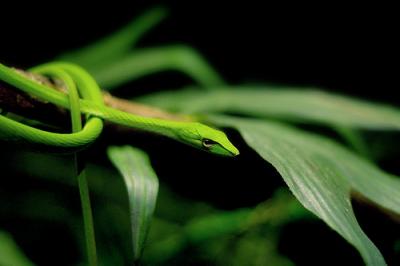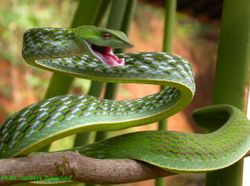Ahaetulla nasuta


Distribution:
This species is native to Southeast Asia. She is living tree in the forest through the trees, bushes, ...
Description:
This species is very thin, green allowing it to blend with its surroundings. His head elongated, mostly level is larger than the body. A line of light color (yellow-white), is located on each side of the animal and the entire length, between the green sheet of yellowish-green back and belly. This species is opisthoglyphe, that is to say, it has a pair of posterior teeth allowing the inoculation of venom. The size of this species varies from 80 to 100 cm.
Behavior:
It is a diurnal and arboreal generally not aggressive, but it should however be handled with care and her throat swells to intimidate. This species moves flexibly and quickly.
Terrarium:
This species promiscuous tree needs a terrarium based on height. A terrarium of 80 x 80 x 100 cm is suitable for a couple. The floor will be filled with pieces of pine or a mixture of river sand and peat.
Many branches and plants (preferably artificial) fill the terrarium to allow the snake to feel secure. In addition, as an arboreal animal, they are indispensable. Note that the animals are usually placed in the foliage. Although this species is refreshed with water spray (to spray on the foliage and animals), a small pool of water kept clean at all times be prepared in the terrarium.
Relative humidity:
The humidity of the terrarium should be kept between 75 and 85%, it will be obtained through the pelvis and sprays warm water several times a week on the foliage. These sprays are almost essential to maintain a sufficient humidity but more importantly, allow the animal to drink.
Temperature:
The ideal temperature is 25-26 ° C in the day with a hot spot at 27-28 ° C. Remove the hot spot at night. This species bears no problems quite low temperatures (15 ° C).
Lighting:
On the diurnal activity, this species needs a light intensity + / - important. We will place a tube providing UVB. The illumination duration will be approximately 12 hours per day.
Power:
The biggest problem with this species in food. Indeed, this species consumes only lizards, amphibians and occasionally arboreal rodents in nature. In captivity, animals from import are more difficult and generally accept that lizards. Sometimes, they accept the little mice, but they can not be his only food. Individuals born in captivity may be less difficult, but it should raise a species of small lizards "easy" to deal with the refusal of rodents. A vitamin supplement is distributed once a week through the prey (subcutaneous injection for the prey).
Reproduction:
Reproduction is still rare for this species but poses no problem if the conditions are met. A rest period may possibly be made (not required) by cutting the hot spot for 2 months (January-February). This species is ovoviviparous, the female gives birth to between 3-9 young (can be +?) Measuring about 29 cm. The gestation period is about 4 ½ months to 5 months. Juveniles look fast enough to feed themselves but they must be generally available to small lizards. Sometimes they accept small pink mouse.
Note:
It is a beautiful species, still fairly uncommon. Maintenance is generally not a problem, which is not the case with food.
This species is absolutely not recommended for beginners.



